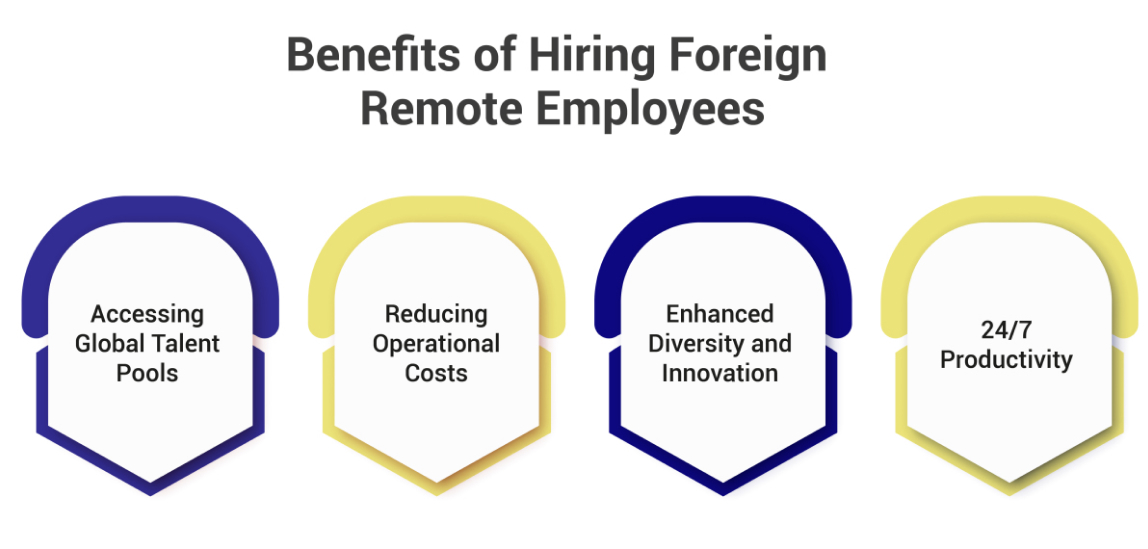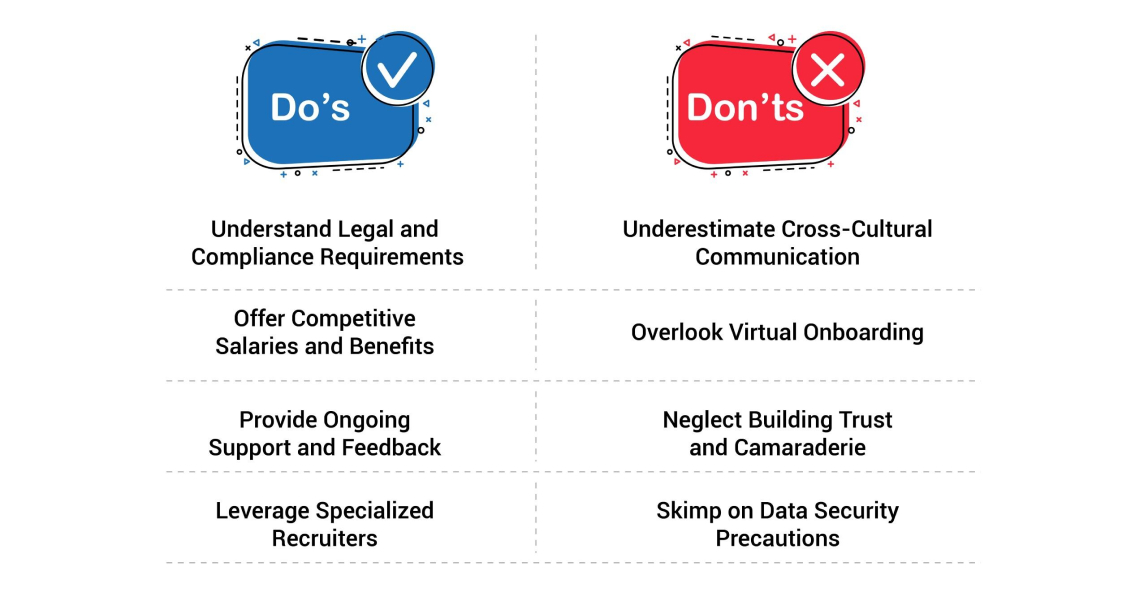
Expanding your talent pool globally can bring immense benefits, from cost savings to accessing specialized skills and diversity perspectives. However, effectively integrating a remote international workforce involves navigating legal complexities around immigration, taxes, and labor laws.
This guide provides tactics and advice on the do’s and don’ts when hiring foreign employees remotely. Follow these best practices for seamlessly expanding your team across borders.
The following are some of the benefits of hiring foreign remote employees:

Hiring talented professionals from overseas talent pools allows organizations to strategically expand their workforce beyond what is available domestically. By tapping into the global labor market, companies gain access to a significantly wider range of qualified candidates that can best match their business needs and advanced skill requirements.
For example, countries like India, China, Eastern Europe, Latin America, and Southeast Asia have immense depth of talent across various high-growth disciplines like technology, design, finance, healthcare, and more. Tech giants like Google, Microsoft, IBM rely heavily on sourcing specialized technical talent from countries like India to support cutting-edge innovation. Even smaller firms are increasingly looking at foreign talent pools to find dedicated software developers, AI experts, data scientists, and other roles that are becoming harder to fill locally.
This is especially relevant for positions that require advanced qualifications, specialized technical abilities, and complex problem-solving skills. An expanded global talent strategy allows organizations to discover motivated professionals that bring unique expertise gained from overseas work contexts. It also gives companies access to relatively untapped talent markets that provide a supply of qualified applicants for critical positions that remain unfilled domestically.
Overall, the depth and diversity of skills available in overseas talent markets today enable organizations to build world-class teams that drive productivity, innovation, and excellence. Rather than being limited by local shortages, companies can strategically access global talent pools to find the best professionals for current and future business needs.
Hiring skilled foreign remote employees can lead to major cost reductions for an organization's human resource expenses and overall operating costs. By leveraging talent from overseas markets, companies can save 30% to 50% compared to the cost of hiring comparable domestic employees. These significant savings apply across salaries, legal and recruitment fees, operational infrastructure, and other costs.
For example, the payroll expenses for specialized roles like software architects, data analysts, financial modelers, and digital marketers can be prohibitive when hiring locally. However, partnering with staffing firms to source qualified remote employees from countries like India, Malaysia, Brazil, Mexico and Eastern Europe allows access to an affordable talent pool. Professionals with similar advanced qualifications often have salary expectations between $15,000 to $35,000 in these countries, whereas the comparable US benchmarks for these roles would exceed $100,000 annually.
Moreover, by using remote working models facilitated by advances in collaboration technologies, organizations also save on typical real estate, equipment, and facilities costs. The cost reduction possibilities enable convenient access to specialized global talent that delivers premium value without the typical price tag. Companies can then reallocate human resource budgets to other mission-critical areas of business operations, development, and innovation.
Hiring overseas remote employees intrinsically contributes to enhanced diversity within teams, which directly leads to improved innovation, solutions, and outcomes for global organizations. By incorporating team members from different cultural backgrounds, companies benefit from an interplay of diverse viewpoints, skill sets, experiences, and approaches to problem-solving.
Having cultural diversity across global teams fosters an inclusive environment where professionals can collaboratively exchange ideas, question assumptions, and come up with creative solutions. For example, designers from Asian markets may offer perspectives on aesthetics and visual communication that complement and build upon the efforts of Western counterparts. Software programmers from Eastern Europe could bring specialized technical approaches that meld with and enhance the efforts of American developers. Such diversity expands the range of talents and angles teams can leverage for excellence.
Research has conclusively indicated that intercultural teams produce more innovation compared to homogenous groups. Exposure to varying cultural insights, communication styles, and contrasting approaches demonstrably enhances creative output over time. The mix of perspectives compels professionals to think outside the box and expand their strategies. Problem-solving also becomes more holistic with diversity. Companies hence achieve more innovative products, solutions, and services by integrating overseas remote talent from different backgrounds.
Building globally distributed teams with foreign remote employees across different time zones greatly enhances productivity and enables close to round-the-clock operations. With team members located across various global regions, organizations can benefit from an overlap in working hours and handoff of critical tasks across geographies. This facilitates uninterrupted progress that would not be possible with localized employee bases.
For instance, a US-based company could collaborate with professionals from Europe in the first half of the day, transition to team members in South America, followed by Asian counterparts - effectively achieving a 24-hour workflow. Software teams working on critical product updates are able to transfer code and fixes seamlessly from one geography to another for quick turnarounds. Marketing teams can disseminate campaign briefs overnight for activation when local markets open across regions.
Such global coordination condenses project timelines, enhances response times to international customers spanning multiple time zones, and powers innovation by building on ideas initiated by previous teams. Not only do overseas employees help cover more hours, but they also enable real-time collaboration to tackle complex workflows and deliverables across geographies.
Hiring remote employees from different countries can help businesses access top talent and expand globally. However, it also comes with challenges like legal compliance, cultural differences, and communication barriers. To ensure a smooth and successful hiring process, follow these key do’s and don’ts:

Before initiating the remote hiring process, research requirements around visas, work permits, taxation, and employment terms for the countries you are recruiting from. Consult specialized immigration attorneys and HR services to ensure compliance. Draft foreign employment contracts aligning with local regulations around minimum wage, working hours, healthcare and benefits.
Stay up-to-date on the latest changes to foreign labor policies and tax codes that could impact your overseas hires. Being mindful of the regulations demonstrates your commitment to supporting your international workforce.
Miscommunication can easily arise when collaborating cross-culturally in a virtual setting. Provide comprehensive diversity and inclusion training to help local staff understand the nuances around working with overseas colleagues from different backgrounds.
Create opportunities for global team members to regularly connect and interact, such as virtual meet-and-greets. Schedule overlaps in work hours across time zones to enable seamless collaboration. Invest in translation services and localization of communications when relevant.
Understand salary expectations and standards of living for the countries your remote employees reside in. Research benchmarks for compensation packages in their local job market to remain competitive. Consider factors like cost of living, infrastructure quality, access to amenities, and more when structuring foreign employee salaries.
For example, paying someone in a developing country the same base rate as a US employee could mean overcompensating them relative to local living costs. Use online calculators to determine appropriate salary adjustments.
Provide comprehensive healthcare coverage as part of your benefits package compliant with regulations in your employees’ countries. You may need to contract insurance providers local to your foreign employees. Other popular perks include retirement plans, vacation days, mental health support, and work from home internet allowances.
A stellar onboarding process is crucial for welcoming foreign hires and setting clear expectations. Invest time upfront to create a detailed onboarding guide covering company history, values, organizational structure, key contacts, and available resources. Schedule one-on-one calls to walk new hires through this manual and answer any questions.
Introduce global team members to the tools and technologies central to their role through interactive tutorials and give them access ahead of their start date when possible. Check in regularly early on to handle any onboarding issues immediately.
To nurture engagement and productivity within your foreign remote workforce, schedule regular one-on-one meetings with managers to discuss progress, provide coaching, and set collaborative goals. Arrange additional mentoring and shadowing opportunities where relevant to support professional development.
Send out pulse surveys periodically to monitor job satisfaction levels and understand any problems international employees may be facing. Proactively address any emerging conflicts between global and local staff through conflict management training or interventions.
Implement online portals or tools for remote employees to transparently track personal targets and access feedback from managers. Celebrate achievements and employee tenure milestones virtually.
While relying primarily on digital communications poses challenges for relationship-building between global team members, invest time into nurturing social connections. For example, you can pair international hires with cultural ambassadors internally to help them navigate company norms and build allies.
Make space for watercooler conversations before or after meetings for colleagues to interact casually. Organize virtual team outings for global employees using geo-tagging features on social media. Send care packages with company swag to make remote staff feel valued.
Keep communication open across the miles by being flexible around meeting times to accommodate different time zones. Embrace over-communication to preempt the isolation that remote foreign employees may feel.
Trying to directly source and vet overseas talent without local expertise can prove difficult. Partnering with international staffing agencies or recruitment firms simplifies global hiring by tapping into existing networks abroad.
Specialized providers handle steps like visa sponsorships, language proficiency checks, cultural alignment assessments and payroll integration legally and seamlessly. This ensures you engage employees with not just technical qualifications but also English language fluency and soft skills to collaborate remotely.
The right recruitment partner already has databases pre-mapped with multi-specialty foreign talent eager to be matched with overseas opportunities. This grants you instant access to pre-qualified candidates rather than having to build connections from scratch.
When managing proprietary information and assets, putting comprehensive cybersecurity protocols in place is especially critical to prevent data breaches. Provide mandatory training to foreign employees on organizational privacy, confidentiality and security policies.
Install reputable VPN and antivirus software across all devices issued to virtual employees to encrypt data. Enable multi-factor authentication on internal platforms hosting sensitive information. Conduct periodic simulated phishing attack tests to assess vulnerabilities proactively.
If remote staff handle customer personal information, ensure databases with such data are password-protected and access is restricted only to authorized employees.
By leaning on these tips for smoothly integrating a foreign remote workforce, you can unlock innovation and give your company a competitive edge globally. Pay close attention to adequately supporting the needs of international hires while aligning them with existing staff. Invest time upfront in building relationships and clarity around policies to maximize productivity.
Hiring overseas remote employees leverages technology to access global talent that drives business growth. By following compliant practices and understanding cross-border cultural nuances, foreign professionals make productive additions to your team. Avoid pitfalls with fair compensation, close monitoring and putting in the extra effort required when hiring abroad remotely. When executed well, this strategy greatly boosts your organizational outcomes through top notch capabilities.